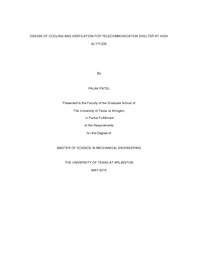
ATTENTION: The works hosted here are being migrated to a new repository that will consolidate resources, improve discoverability, and better show UTA's research impact on the global community. We will update authors as the migration progresses. Please see MavMatrix for more information.
Show simple item record
| dc.contributor.author | Patel, Palak | en_US |
| dc.date.accessioned | 2015-07-31T22:10:21Z | |
| dc.date.available | 2015-07-31T22:10:21Z | |
| dc.date.submitted | January 2015 | en_US |
| dc.identifier.other | DISS-13190 | en_US |
| dc.identifier.uri | http://hdl.handle.net/10106/25125 | |
| dc.description.abstract | Telecommunication shelters house information technology (IT), networking, power, and cooling equipment such as racks, power cabinets, batteries, fans, etc. For reliable operation of the IT and networking equipment, shelters need to satisfy or exceed minimum environmental guidelines for all equipment they contain. These guidelines typically contain specified operational temperature, maximum gaseous and particular contaminant levels. In this work, cooling and ventilation needs of a telecommunication shelter at an altitude of 9,678 feet are studied by modeling the system and simulating various operational and weather scenarios using FloVENT 10.1, a computational fluid dynamics (CFD) tool. The shelter contains two compartments: the IT compartment and the battery compartment. The IT compartment contains Electronic equipment which generate specific amount of heat. The battery compartment contains three Lead Acid Gel Type battery strings. During charging of the batteries, Hydrogen gas is generated which is released into the shelter. Sufficient ventilation is needed to keep the level of Hydrogen in the shelter under 2% concentrations by volume level. Amount of Hydrogen generation by the batteries and heat dissipation by all electronic components in the shelter varies during day or night time. This study contains the worst case scenarios during winter and summer which are studied assuming steady state conditions. Due to accumulation of hot air and hydrogen near roof line, Exhaust is shifted to top and also two small holes are created to provide proper ventilation. Supplemental heating is provided for winter to keep temperature at desired level. By providing inlet blowers and above briefed ventilation, it has been noticed that maximum temperature and hydrogen level is achieved as desired. | en_US |
| dc.description.sponsorship | Agonafer, Dereje | en_US |
| dc.language.iso | en | en_US |
| dc.publisher | Mechanical Engineering | en_US |
| dc.title | Design Of Cooling And Ventilation Of Telecommunication Shelter At High Altitude | en_US |
| dc.type | M.S. | en_US |
| dc.contributor.committeeChair | Agonafer, Dereje | en_US |
| dc.degree.department | Mechanical Engineering | en_US |
| dc.degree.discipline | Mechanical Engineering | en_US |
| dc.degree.grantor | University of Texas at Arlington | en_US |
| dc.degree.level | masters | en_US |
| dc.degree.name | M.S. | en_US |
Files in this item
- Name:
- Patel_uta_2502M_13190.pdf
- Size:
- 1.580Mb
- Format:
- PDF
This item appears in the following Collection(s)
Show simple item record


